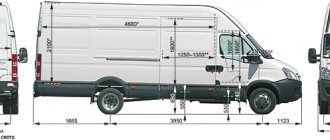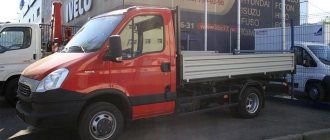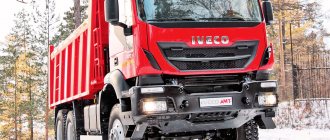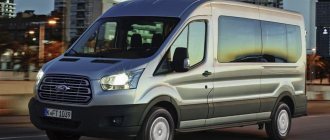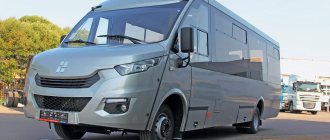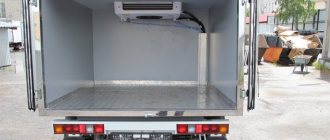Andrey Filippov, photo by the author
I’m not a big fan of presentations – there’s a lot of interesting stuff, not enough time, and the result is usually a feeling of dissatisfaction. I expected the same impressions from the premiere show of the updated IVECO EcoDaily and I was almost not mistaken. Six hours for nine models and a press conference is not a lot. But there was no dissatisfaction. The Daily line turned out to be so bright that I could not have digested more impressions even if I wanted to. The EcoDaily model range turned out to be surprisingly wide, so following the saying “brevity is the sister of talent,” you need to choose the most interesting.
Use, types, principle of operation of refrigerated trucks
Depending on the temperature that is constantly maintained inside the van, refrigerators are divided into three groups:
- Class A
- temperature from +12°C to 0°C - Class B
- temperature from +12°С to -10°С - Class C
- temperature from +12°С to -20°С
There is a standard procedure for determining temperature: the temperature regime is measured in an empty body, provided that the outside air is heated to +30°C.
For transporting fresh meat and fish, butter, sausages, eggs, etc. Class A refrigerated trucks are sufficient. Frozen foods (meat, fish, vegetables) require a Class C refrigeration unit.
When choosing a refrigerated van, you should pay attention to the following conditions: outside temperature, frequency of door openings, level of thermal insulation, general operating conditions.
Dimensions:
| A – Wheelbase, mm | 3 750 |
| B – Vehicle length, mm/td> | 6 523 |
| C – Front overhang, mm | 1 008 |
| B – Rear overhang, mm | 1 765 |
| E – Cabin width, mm | 2 010 |
| K – Cabin height (without load), mm | 2 220 |
| L – Height along the frame (without load), mm | 736 |
| M – Front wheel track, mm | 1 696 |
| N – Rear wheel track, mm | 1 540 |
Weight:
| Permissible total weight, kg | 3 500 |
| Permissible total weight as part of a road train, kg | 7 000 |
| Maximum load capacity (chassis), kg | 1 518 |
| Vehicle curb weight, kg | 1 982 |
| Including front axle, kg | 1 320 |
| Including rear axle, kg | 605 |
| Max. Permissible load on the front axle, kg | 2 100 |
| Max. Permissible load on the rear axle, kg | 2 600 |
Cabin: Daily
- – All-metal, two-door
- – Short (day)
- – Triple (1+2), without bed
Engine: HPI / F1CE0481FA / 146 hp
– Diesel 4-cylinder in-line, equipped with a turbocharging system and a WateGate valve, an intercooler for the air supplied to the cylinders. Direct fuel injection into the cylinders is carried out via an electronically controlled Common Rail system. EGR system, exhaust gas catalytic neutralization system.
| Engine displacement | 2,998 cm3 |
| Number of valves | 16 |
| Maximum engine power | 146 hp (107 kW) at 3,000 – 3,500 rpm. |
| Maximum torque | 350 Nm in the range of 1,400 – 2,600 rpm. |
The content of toxic substances in exhaust gases complies with EURO 5 standards.
Clutch:
- – Dry single-disc, with diaphragm spring
- – Outer diameter 11”
- - Hydraulic drive. Automatic adjustment
Transmission: ZF 6S400 OD
- – Mechanical, synchronized gearbox with cable drive
- – Number of stages 6+1
Axles:
- – Front (1st): non-leading controlled
- – Rear (2nd): drive not controlled, gear ratio 4.56
Suspension:
- – Front (1st): Independent, torsion bar with anti-roll bar and hydraulic telescopic shock absorbers
- – Rear (2nd): Dependent, parabolic leaf spring with anti-roll bar and hydraulic telescopic shock absorbers
Tires and wheels:
- – 195/65 R16 – front and rear axle
- – Tires: front axle – single-pitch, rear axle – dual-pitch
- – Disks: steel 6JK 16 – front and rear axle
Steering: ZF 7852 or TRW 15
- – Steering mechanism “Gear-Rack”
- – Hydraulic booster
Brake system:
- – Hydraulic double-circuit with vacuum booster
- – Electronic stability control system ESP 9, including:
- – Anti-lock braking system ABS
- – Traction control system ASR
- – Electronic brake force distribution system EBD
- – HBA Brake Assist
- – Electronic torque control system MSR
- – Electronic brake force limiter EBD
- – Hill Holder Hill Start Assist System
- – Brakes, type: for all axles – disc
Electrical system:
| Voltage: | 12 V |
| Accumulator battery : | 12 V / 110 Ah. |
| Generator: | 14 V / 110 A |
| Starter: | 2.2 kW |
Bucky:
- – Plastic fuel tank, l. : 70
- – Heated fuel filter
Cabin color:
- White (White IC194)
Iveco commercial trucks equipped with refrigerated compartments
IVECO trucks equipped with refrigeration units are characterized by cooling class and load capacity. For most intracity transportation, it is enough to purchase a small van, while for intercity transportation of perishable goods, you will need a powerful refrigerated van equipped with a semi-trailer with a substantial volume and, accordingly, a large loading capacity.
All IVECO commercial equipment with refrigerated trucks fully complies with modern requirements, has all established certificates guaranteeing the non-toxicity of the materials and refrigerants used, as well as compliance of the parameters with the class specified in the passport.
Extras
There were three cars at the presentation, available for viewing only. IVECO Daily 35S14/3.0 is a brother (the difference in factory serial numbers is one unit) of the same car available for driving, but the inability to ride the other two was a little disappointing.
It would be interesting to drive around in a cramped area with the Tsentrtranstekhmash-4742 van on the IVECO Daily 65C18 chassis. Whatever one may say, the “booth” still limits the view to the rear, despite the elongated mirror mounts. And the question of how a seemingly well-made superstructure will behave on an uneven road, unfortunately, remains open.
And I don’t think it’s worth even talking about the relevance of the topic of minibuses. "Nizhegorodets-2227UTA" on the IVECO Daily 50C15VH chassis is designed for urban transportation. There are no changes in the cabin, except that a Webasto remote control has appeared, a light and ventilation control unit in the passenger part and a funny button with a “pipe” symbol, exactly the same as in the cabin - there it is assigned the function of requiring a stop. The driver, of course, is able to stop himself, so the button simply opens and closes the passenger door.
But the inside of the former naked van is unrecognizable. Now it can comfortably carry 19 seated and 7 standing passengers. The orange-gray interior is very light and feels even larger than it actually is. I definitely liked that there is a distance between the seats so that you don’t have to squeeze in and your knees don’t rest against the backrest. An automatic door is also good, the fastening mechanism of which will not disturb the passenger sitting next to it. In minibuses with self-installed electric locks, such proximity is not always pleasant.
Although not everything is perfect in Nizhny Novgorod. For example, I’m not happy with the metal footrest sticking out to the side. And a handrail under the ceiling on only one side is not the best solution. What if you need to find an object outside the window on the left or is it more convenient to stand facing the twin seats?
But the overall verdict is that this is one of the best minibuses I have seen.
Buy IVECO refrigerator new and used
offers refrigeration units assembled on the basis of Iveco commercial trucks. The work rules that we adhere to in our company go far beyond the banal exchange of goods for money. We are interested in creating long-term and trusting relationships with each client, offering official maintenance of any Iveco equipment at our own technical center. Working with us is a guarantee that only branded Iveco spare parts will be used to repair your car. In addition, we provide professional advice on the purchase, maintenance and operation of commercial vehicles. You can get detailed information from our managers.
Refrigerators are a special type of semi-trailers with high thermal insulation characteristics. Their design allows you to maintain a stable temperature inside. They are used for transportation of chilled and frozen food and non-food products.
Main characters
There were two such cars, and let’s start, perhaps, with a small one, if that’s what you can call a car more than five meters long and more than two meters high. The EcoDaily 35S14/3.0 differs from the rest of the equipment shown at the presentation by its low load capacity, a transverse spring in front instead of torsion bars and... a robotic gearbox. It feels like a robotic gearbox is the same six-speed gearbox, but you don’t need to move the lever. Switching delays are at an acceptable level. No problems were found on wet clay or with different surfaces under the wheels. And if you still want to change gears yourself, then there is such an opportunity. Anyone who still claims that a “robot” is an unnecessary luxury on a city van should “hang” with it in a traffic jam once, and he will change his mind.
The second car is EcoDaily 65C17V. This is no longer even an analogue of Zilov’s “Bull”, but a more serious technique. The funny thing is that if you don’t look closely, the Daily is unremarkable, except that the roof is higher. But upon closer examination, you notice a higher landing, a “non-childish” rear axle and a thick set of springs, which confirm that this is a full-fledged truck. However, if you sit behind the wheel, the only thing that indicates this fact is the additional handrails on the A-pillars. In terms of acceleration, handling, and smoothness, I didn’t feel much of a difference. At least with an empty car you can safely set the speed of city traffic.
Models 35C17, 50C15, 50C17 also did not disappoint, and we even tested the IVECO Daily 50C14GV with a natural gas engine separately, and the material will be published in the next issue.
Iveco Daily real fuel consumption per 100 km: reviews
- Vladislav, Igoropavlovsk. I got the Iveco Daily tow truck from the first owner, who worked for himself and took orders. The car was produced in 2006, with a current mileage of 170 thousand kilometers. This is my second year driving the car, I bought it for one and a half million rubles. A little expensive, but the car is worth the money spent. It has an impressive 4.5-liter diesel with 177 horsepower, rear-wheel drive, and a crisp manual transmission. In short, the reserve of traction force is huge, it’s not even a matter of acceleration kinetics. The car takes on any hill with pleasure, even the most uphill. The average fuel consumption is 13-14 liters per hundred kilometers.
- Arthur, Salekhard. The car cost me 320 thousand rubles. Iveco Daily all-metal van, model 2014, was purchased at the Fortuna auto center. Model with a three-liter 145 hp. diesel and manual, white body, no pitfalls (no rust or other problems). A very practical and heavy-duty vehicle, in city traffic it manages to get 13 liters per hundred kilometers.
- Ilya, Ussuriysk. I ride an Ievco Daily manufactured in 2010. I've been working on it for four months. The car is a refrigerated truck with a carrying capacity of 1800 kg. The 2.3-liter diesel unit with 106 horsepower operates with a manual transmission and consumes 11 liters per hundred kilometers. The car consumes 9 liters/100 km on the highway. A vehicle with a strong cargo chassis that can withstand any container. This machine is not afraid of any overloads. An important advantage is high efficiency and a power unit that is unpretentious to fuel quality. It’s moderately noisy inside; at city speeds it’s possible to talk in a low voice. The car is quite torquey and passable, with a durable chassis and powerful brakes.
- Konstantin, Izhevsk. I am the owner of an Iveco Daily manufactured goods van with a number on the odometer of 3000 thousand km. A car with a three-liter diesel power unit. This proven engine produces 146 horsepower and is undemanding when it comes to fuel quality. No difficulties or malfunctions arise, except perhaps as part of scheduled maintenance. The car is dynamic and load-bearing, in city mode it consumes about 11-13 liters per hundred kilometers.
- Vladimir, Kalmykia. I have a flagship Iveco Daily with a number on the odometer of 270 thousand kilometers. Model manufactured in 2012, all-metal van with a load capacity of 4500 kg. The car was taken for 1 million rubles. This machine is worth the money spent. It has two main advantages - load capacity and a practical motor. The kinetics are eye-catching, the engine tears and rushes at a wide frequency of engine speeds. In the city it consumes approximately 13 liters, and outside the city it is 11 liters per hundred kilometers.
- Ilya, Kazan. I have an Iveco Daily made in 1996. A good old workhorse, it will last another three years, maybe more. Ordinary and unpretentious in service. The car is white, in a traditional van body with a carrying capacity of 1500 kg. The car is equipped with 80hp. a 2.5-liter diesel engine, rear-wheel drive and a minimal set of useful options. Iveco Daily is designed for transporting goods not only on smooth roads, but also on winding rural paths, rough terrain, etc. In the city, a car consumes 13 liters per hundred kilometers, and on the highway it is 9 liters per hundred kilometers. In the end, I liked this all-metal van. After two years of active use, I adapted to garage repairs thanks to Iveco Daily. Currently, the mileage meter shows 200 thousand km, but the car is at full speed.
- Valery, Ussuriysk. I ride an Iveco Daily manufactured in 2012. Chassis modification with a three-liter diesel engine with a maximum maximum power of 146 horsepower. I bought this car with minimal mileage (1500 km) at an auto center. The car cost 1.2 million rubles. The model is white, absolutely zero. We were pleased with the carrying capacity, strong chassis, spacious interior and low fuel consumption - in urban mode it comes out to approximately 11-12 liters.
- Roman, Yakutsk. I have a zero Iveco Daily in a refrigerator body, with a load capacity of 2900 kg. car produced in 2022, with a three-liter diesel engine. power unit maximum maximum power of 146 horsepower, with rear-wheel drive. The car looks impressive, I'm talking about the cabin. The Italians are certainly great for creating such a mega-designer cabin. I bought a car for 2.8 million rubles to fulfill orders, I work for myself. A diesel engine with a maximum maximum power of 146 horsepower consumes no more than 14-15 liters per hundred kilometers, this is when loaded.

